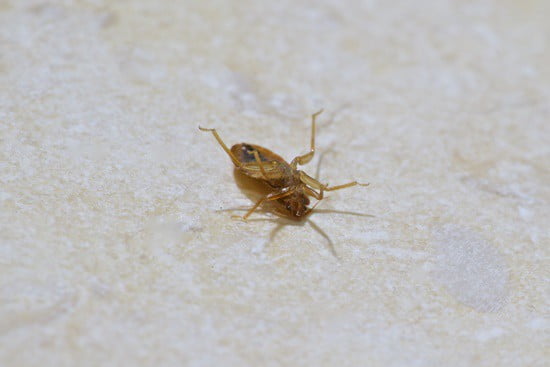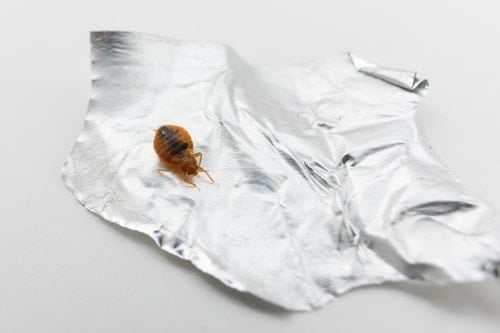Bed bugs can’t live outside, so they’ve learned how to move on man-made surfaces that you find around the house. Surfaces like plastic, glass, and smooth metal don’t exist in nature. Bed bugs can walk across these surfaces, and can even climb most of them.
Bed bugs can walk horizontally across any surface. Bed bugs are light and have small hooks on their feet that they use to grip onto smooth and slick surfaces so they don’t fall. They can vertically climb walls, wood, and some types of plastic, but not glass.
Bed bugs have legs like any other bug. They use their six legs to scuttle around from place to place. Unlike other bugs, bed bugs can’t fly or jump. All they can do is crawl around. If a place isn’t accessible by crawling, then bed bugs are unable to get there.
Can Bed Bugs Walk on Plastic?
There is mixed anecdotal evidence as to whether bed bugs can walk on plastic. There are certainly some plastics that bed bugs can’t climb. Bed bug interceptors are small traps that fit around the feet of your bed. They are made of smooth plastic.
The bed bugs can climb in, but can’t climb out again. They are best used to identify whether an infestation is present, rather than to control it. They can be filled with a small amount of water to drown the bed bugs too.
However, it’s reported that some bed bugs can climb out if no water is present. Tropical bed bugs are better at climbing than native U.S. bed bugs. They can climb out of some interceptors.
Aside from interceptors, bed bugs can easily walk on plastic. They can walk across plastic tables, electronics, flooring, or anything else made from the material.
Can Bed Bugs Walk on Metal?
Bed bugs can walk on metal, although it’s more difficult than other surfaces for them. While man-made metal surfaces look smooth, on a microscopic level, they aren’t. These tiny pits and jags give the bed bug plenty to hold on to.
But if the metal is vertical, it may be too smooth for them to climb on. That wouldn’t stop them trying, as they would keep wanting to reach you. Eventually, they would give up and find another surface to climb e.g. a wall.
If the metal is polished and smooth, it definitely won’t be easy for them to climb. Only when metal is rough and pitted, or at least textured, will they have a chance.
Can Bed Bugs Walk on Hardwood Floors?
Bed bugs can easily walk on hardwood floors. Floorboards are flat, even if you’re as small as a bed bug. They don’t find it hard to walk across them.
The only hazard is that the floorboards likely have gaps between them. The bed bug could fall into one of these gaps. However, they could easily climb out again and carry on, on their journey.
Even though they can, you aren’t likely to see a bed bug walking on your hardwood floor. That isn’t because they can’t, or that they don’t like the surface.
It’s because bed bugs don’t like walking around open spaces. That’s the case if it’s the daytime, and there’s sunlight streaming in. Bed bugs are photophobic, so try to hide when they see the sun.
The smoother the floor, the harder it is for them to travel across. If yours is a polished hardwood floor, then it will be even more difficult. They can’t move at max speed as they have no grip.
Can Bed Bugs Walk on Tiles?
Tiles are similar to hardwood floors for bed bugs. They have bumps that the bed bugs can use to move forward. In between the tiles are grooves that might slow their progress, but not stop them.
The same drawbacks that apply to hardwood floors apply to tiles too. Bed bugs hate sunshine, so they won’t walk around a sunny room. They would rather stay hidden and wait until the night to move around.
Bed bugs rarely go to places where there are tiles. They don’t go to the bathroom, because their host doesn’t sleep there. They don’t go to the kitchen because they don’t feed on food scraps.

Can Bed Bugs Walk on Carpet?
Of any surface, bed bugs dislike carpet most (although this depends on the type). They don’t like to walk across it. That’s because carpet isn’t flat at all, but lumpy and bumpy. The longer the carpet, the more difficult it is for them to crawl on.
Have you ever picked up an insect, and it’s struggled to walk through your arm hair? When a bug has short legs, it can find it difficult to walk through hairs. It will try to climb over one, only to have to climb another.
The same may apply to your carpet. If it’s long, the bed bug can only walk slowly. It will struggle as its feet slip into gaps, and it has to climb over what, to the bed bug, are like big bumps in the road.
That being said, bed bugs can like certain kinds of carpet. If there is a gap between the carpet and the wall, bed bugs can hide there. They may also get through holes in the carpet to hide underneath.
Surfaces Bed Bugs Can’t Climb
Bed bugs are surprisingly good climbers. They are comparable to elite-level human rock climbers, in that they can climb vertical surfaces with a minimum of handholds. They do so without protective equipment, but even if they fall, they aren’t harmed.
However, there are also certain surfaces that they can’t climb. If the surface is the wrong texture, they will struggle to get any purchase on it. This especially applies if the surface is entirely vertical.
Bed bugs have small hooks on their feet that they use to find grip and move upwards. It’s only if the surface has places they can grip with these hooks that they can climb up it.
Bed bugs are known to climb walls, wood, some kinds of plastic, and more. Almost any material found in your bedroom is climbable for them. That’s because there are lots of ‘handholds.’
They need to climb surfaces like these. Bed bugs don’t only live in your mattress. They can live anywhere in your room. If these bugs want to reach you, they’ll have to climb either the wall or the bed frame.
Can Bed Bugs Climb Smooth Surfaces?
Smooth surfaces are what bed bugs struggle to climb the most. They need footholds that they can put their feet into so that they can push up. Bed bugs are the same as any rock climber in that way.
However, what may seem smooth to you may be fine for a bed bug to climb. Wood seems smooth, for example. But if you peer close, there are lots of places for them to get a grip.
One smooth surface they can’t climb is glass. Glass is completely smooth, with no cracks or gaps for them to climb up. It is one of the surfaces that no bed bug can climb, no matter how much they try.
But even smooth plastics may be climbable for them. They are aided by the fact that they are light. Bed bugs hardly weigh a thing, so don’t need to expend much effort to stop themselves from falling.
Can Bed Bugs Climb Hard Surfaces?
Hard surfaces are no problem for a bed bug. They can easily climb something solid like wood, for example. While it is hard, it has lots of places for them to grip. The only issue is if the surface is hard and smooth. If that’s the case, then they won’t have any way to climb.
Can Bed Bugs Walk on Walls?
Bed bugs are known to walk on walls. Like other surfaces, they may look smooth, and don’t offer anything for bigger animals like us to grip. But if you were the size of a bed bug, there are plenty of places for them to hook their feet.
Brickwork is the easiest to climb. Bricks are roughly textured. The gaps between them are textured too, more finely, but still easy enough to climb.
Even plaster has places for bugs to grip. If you look closely, it’s uneven enough that it’s like the kind of rock face a person could climb. Run it under your fingers and you’ll feel that effect, too.
What Flooring to Use to Stop Bed Bugs
Smooth flooring or wall coverings are the best option to stop bed bugs. These are the ones they struggle to walk on or climb the most. Smooth linoleum or tiling would be good options, although these are unsuitable for bedrooms.
However, don’t design your room solely to stop bed bugs. There are much better ways to control them than by picking a certain floor or wall covering.
That’s because bed bugs can move around in more ways than walking. For example:
- They frequently hitch a ride with an unsuspecting person, climbing into your belongings
- They can climb through gaps in the wall and travel through the house that way
- They can climb the wall, avoiding the floor, or walk across the floor avoiding the wall
Even if you picked the best flooring for bed bugs, they could still move from place to place. A better idea is to kill bed bugs and eggs in your home with heat.

